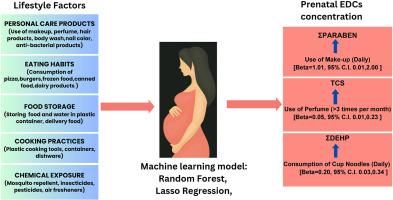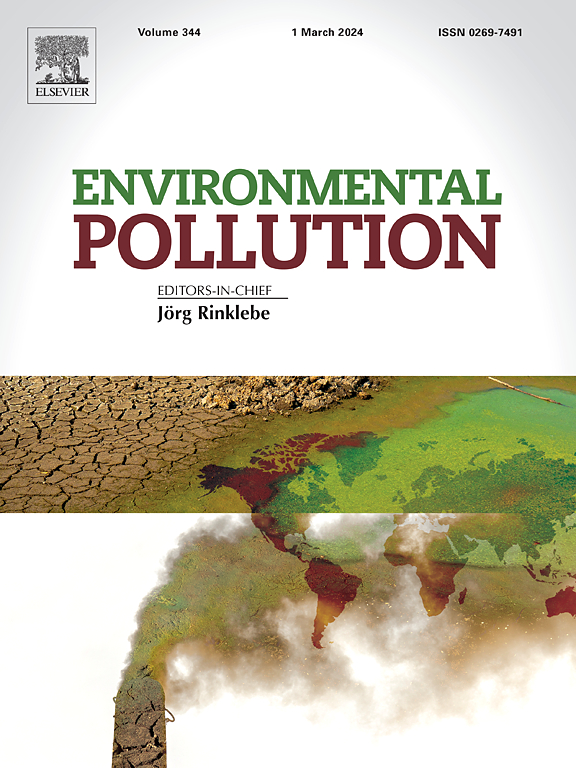孕妇的生活方式与干扰内分泌的化学品暴露:一种机器学习方法
IF 7.6
2区 环境科学与生态学
Q1 ENVIRONMENTAL SCIENCES
引用次数: 0
摘要
妇女无处不在地接触到个人护理产品、食品包装和加工过程中存在的各种干扰内分泌的化学物质(EDCs)。怀孕是一个更容易受到环境压力影响的阶段。因此,我们旨在通过问卷调查,找出影响产前 EDCs(双酚 A(BPA)、三氯生(TCS)、对羟基苯甲酸酯和邻苯二甲酸酯)浓度的孕妇生活方式变量。我们还旨在探讨这些生活方式因素与韩国孕妇暴露于 EDC 之间的关联。这项研究是韩国儿童环境健康研究(Ko-CHENS)的一部分。通过问卷调查评估了以下生活方式因素:个人护理产品的使用、饮食习惯、烹饪方法、食物储存方法和化学物质暴露。我们研究了产前 EDCs:酚类(BPA)、三氯碳氢化合物、对羟基苯甲酸酯类(MEP、ETP 和 PRP)和邻苯二甲酸酯类(MEHHP、MEOHP、MECPP、MBZP、MCOP、MCPP、MCNP 和 MNBP)。我们使用随机森林和最小绝对收缩及选择算子回归机器学习模型来预测影响孕妇产前 EDC 浓度的重要生活方式因素。接下来,我们分别计算了生活方式得分并评估了其与产前 EDCs 的关联。我们的结果显示,使用化妆品[β:1.01,95% C.I.:0.01,2.00]>6次/周的孕妇的孕早期(EP)ΣParaben暴露量显著增加。使用香水达 3 次/月与 EP TCS 暴露显著相关(β:0.05,95% C.I.:0.01,0.23)。而每周使用香水 6 次与孕晚期(LP)ΣParaben 暴露显著相关,食用杯面显著增加 LP ΣDEHP 暴露。线性模型分析表明,生活方式得分会明显增加 EP(β:0.24,95% C.I.:0.07,0.40)和 LP(β:0.10,95% C.I.:0.01,0.20)ΣParaben 暴露量。因此,孕妇的生活方式(如使用化妆品和香水)和饮食习惯(如食用杯面)与产前摄入 EDC 相关。本文章由计算机程序翻译,如有差异,请以英文原文为准。

Pregnant women’s lifestyles and exposure to endocrine-disrupting chemicals: a machine learning approach
Women have ubiquitous exposure to various endocrine disrupting chemicals (EDCs) present in personal care products, food packaging, and processing. Pregnancy is a phase of increased vulnerability to environmental stressors. Therefore, we aimed to identify questionnaire based variables of pregnant women’s lifestyle factors affecting the prenatal concentrations of EDCs: bis-phenol A (BPA), triclosan (TCS), parabens, and phthalates. We also aimed to explore the association between these lifestyle factors and EDC exposure in pregnant women in South Korea. This study is a part of Korean CHildren’s ENvironmental health Study (Ko-CHENS). The following lifestyle factors: usage of personal care products, eating habits, cooking practices, food storage practices, and chemical exposure were evaluated through questionnaire. We examined prenatal EDCs: phenols (BPA), TCS, parabens (MEP, ETP, and PRP), and phthalates (MEHHP, MEOHP, MECPP, MBZP, MCOP, MCPP, MCNP, and MNBP). The random forest and least absolute shrinkage and selection operator regression machine learning models were used to predict the important lifestyle factors affecting the prenatal EDC concentrations in pregnant women. Next, we calculated the lifestyle score and evaluated its association with prenatal EDCs, respectively. Our results show that pregnant women who used makeup [β: 1.01, 95% C.I.: 0.01,2.00] >6 times/week had a significant increase in early-pregnancy (EP) ΣParaben exposure. Using perfume up to 3 times/month was significantly associated with EP TCS exposure (β: 0.05, 95% C.I.: 0.01,0.23). While, using perfume >6 times/week was significantly associated to late-pregnancy (LP) ΣParaben exposure, and consuming cup noodles significantly increased LP ΣDEHP exposure. Linear model analysis showed that the lifestyle score significantly increased the EP (β: 0.24, 95% C.I.: 0.07,0.40) and LP (β:0.10, 95% C.I.: 0.01,0.20) ΣParaben exposure. Therefore, pregnant women’s lifestyle factors, such as using makeup and perfume and eating habits (e.g., cup noodle consumption), were associated with prenatal EDC exposure.
求助全文
通过发布文献求助,成功后即可免费获取论文全文。
去求助
来源期刊

Environmental Pollution
环境科学-环境科学
CiteScore
16.00
自引率
6.70%
发文量
2082
审稿时长
2.9 months
期刊介绍:
Environmental Pollution is an international peer-reviewed journal that publishes high-quality research papers and review articles covering all aspects of environmental pollution and its impacts on ecosystems and human health.
Subject areas include, but are not limited to:
• Sources and occurrences of pollutants that are clearly defined and measured in environmental compartments, food and food-related items, and human bodies;
• Interlinks between contaminant exposure and biological, ecological, and human health effects, including those of climate change;
• Contaminants of emerging concerns (including but not limited to antibiotic resistant microorganisms or genes, microplastics/nanoplastics, electronic wastes, light, and noise) and/or their biological, ecological, or human health effects;
• Laboratory and field studies on the remediation/mitigation of environmental pollution via new techniques and with clear links to biological, ecological, or human health effects;
• Modeling of pollution processes, patterns, or trends that is of clear environmental and/or human health interest;
• New techniques that measure and examine environmental occurrences, transport, behavior, and effects of pollutants within the environment or the laboratory, provided that they can be clearly used to address problems within regional or global environmental compartments.
 求助内容:
求助内容: 应助结果提醒方式:
应助结果提醒方式:


